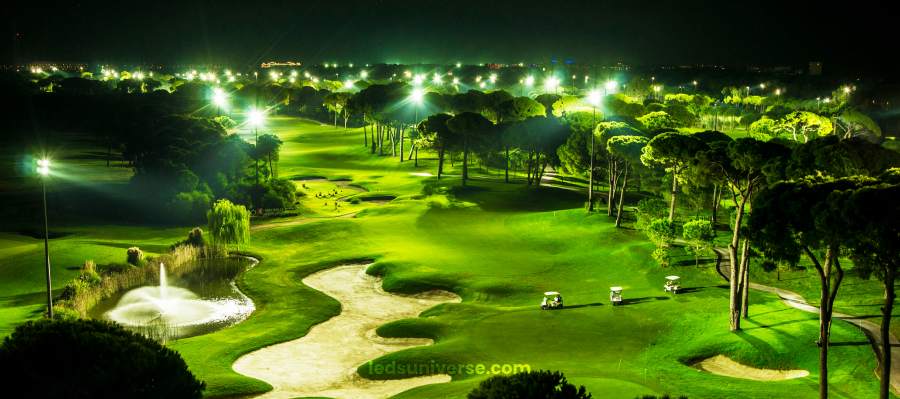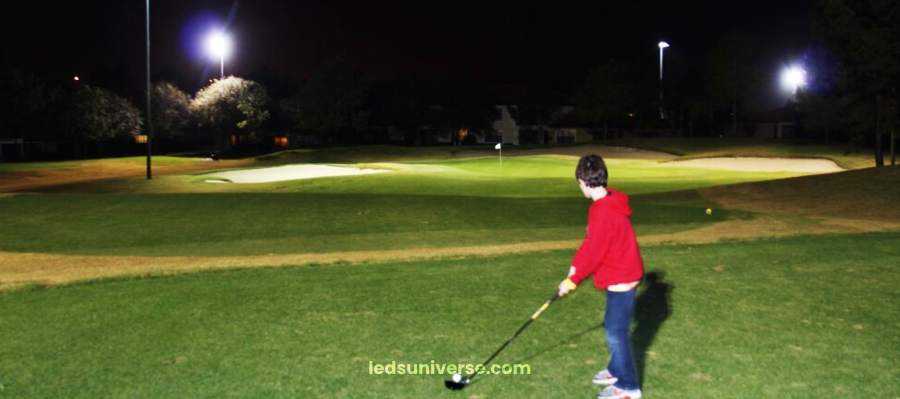Lighting on a golf course isn’t just about illuminating the fairways; it’s about creating an atmosphere that enhances every swing, putt, and drive while ensuring safety and enjoyment. In the world of golf course lighting, LED technology has revolutionized the game by offering powerful illumination with remarkable energy efficiency and longevity.
Proper illumination allows players to enjoy the game while maintaining the integrity of the golf course’s aesthetics and layout. Effective lighting enhances not only the gameplay but also the overall experience of the players. As golf courses vary in size, terrain, and layout, the lighting solutions must be tailored to meet specific needs while adhering to regulations and standards.
Reach out for free lighting consultation
Table of Contents
ToggleLED technology has revolutionized golf course lighting, providing high luminous efficiency, energy savings, and long-term durability. LED floodlights are commonly used to cover large areas with bright, consistent light. These lights are equipped with optical systems that include lenses and adjustable angles to focus light precisely where it is needed. This feature is crucial for illuminating various elements of the golf course, such as fairways, greens, and hazards, ensuring players can track the ball and assess the terrain effectively.

Modern LED floodlights offer powerful illumination with minimal power consumption. They are designed to provide uniform light distribution over long distances, often ranging from 100 to 150 meters. This capability ensures that the entire playing field is well-lit, reducing shadows and enhancing visibility. Additionally, floodlights are often equipped with adjustable mounts and protective casings to withstand harsh environmental conditions.
For golf courses that are still in development or require temporary solutions, mobile lighting units offer a flexible and effective option. These stand-alone systems can be easily moved and positioned as needed, providing temporary but high-quality lighting. Mobile units often use high-power LED spotlights and can serve as temporary solutions until permanent lighting installations are completed. They are also useful for testing and simulating different lighting configurations before final installation.
Golf course lighting must adhere to a variety of international standards to ensure safety, performance, and environmental sustainability. These standards are designed to provide a framework for the consistent quality of lighting installations across different locations and applications.
One of the considerations in international lighting standards is the brightness level, often measured in lux. Golf course lighting must be bright enough to ensure clear visibility of the playing area, yet not so intense as to cause discomfort or impair vision. Standards typically set specific lux requirements for different areas of the course, such as fairways, greens, and hazards, to ensure uniform visibility and safety. For instance, the International Golf Federation (IGF) provides guidelines that specify the minimum lux levels required for various types of play, including amateur and professional tournaments.
International standards address this by setting maximum allowable limits for light variation across the course. A well-lit golf course should exhibit minimal contrast between illuminated and shadowed areas to ensure that players can track the ball and assess the terrain accurately. Standards often include metrics for uniformity ratios, ensuring that light distribution is even and that no areas are significantly darker or brighter than others.
Excessive glare can impede players’ vision and affect their performance. Standards recommend the use of fixtures designed to minimize glare, such as those with glare shields or specialized optics. Proper positioning and angling of lights are also essential to prevent direct light from shining into players’ eyes or creating distracting reflections on the course.
Compliance with international standards also involves rigorous testing and quality assurance of lighting equipment. Fixtures must undergo evaluations to verify their performance against established benchmarks. This includes testing for durability, light output consistency, and energy efficiency. Manufacturers of golf course lighting solutions are often required to provide documentation and certification proving their products meet these standards.
In addition to global standards, golf course lighting must comply with local regulations, which can vary widely depending on the location. These regulations are designed to address specific regional concerns and ensure that lighting installations are appropriate for the local context.
One major local concern is light pollution, which refers to the excessive or misdirected artificial light that can impact the surrounding environment. Many local jurisdictions have regulations aimed at minimizing light pollution to protect natural ecosystems and preserve the night sky. These regulations may dictate the types of fixtures used, the direction of light, and the intensity of illumination to reduce light spill and skyglow. For example, some areas require the use of full-cutoff fixtures that direct light downward and minimize glare.
Local regulations may also emphasize energy efficiency and sustainability. Municipalities or regions with a focus on environmental conservation might have specific requirements for using energy-efficient lighting technologies. This often includes the use of LED fixtures, which offer significant energy savings compared to traditional lighting options. Local guidelines may also set limits on the maximum allowable power consumption for lighting systems to encourage the adoption of energy-saving practices.
Golf courses located in residential or scenic areas may be subject to guidelines that address the visual impact of lighting on the surrounding landscape. Regulations may require that lighting designs harmonize with the natural environment and architectural features of the area. This ensures that the lighting contributes positively to the visual appeal of the golf course and does not detract from the beauty of the surroundings.
Adhering to local regulations helps maintain positive relationships with the community. Properly managed lighting minimizes disruptions to nearby residents and reduces potential conflicts over issues such as light trespass and glare. By engaging with local authorities and addressing their concerns during the planning and installation phases, golf course operators can foster goodwill and support for their lighting projects.
Before installing lighting systems, golf course operators often need to obtain permits and approvals from local authorities. This process ensures that the proposed lighting meets all regulatory requirements and does not have adverse effects on the community or environment. Operators must submit detailed plans and specifications for review, and in some cases, conduct public consultations to address any concerns raised by residents or stakeholders.

The integration of lighting with the golf course’s design and layout is essential for both enhancing the player experience and maintaining the integrity of the course. Effective lighting should harmonize with the natural topography and architectural features of the golf course, ensuring that each area is illuminated according to its specific needs and characteristics.
Golf courses typically feature a variety of terrain, including fairways, greens, bunkers, and rough areas. Each of these elements has distinct visibility requirements. For instance, the fairways and greens are the primary areas where accurate ball tracking and precise shot placement are crucial. Therefore, these areas need higher illumination levels to ensure that players can clearly see the ball and the layout of the course. On the other hand, rough areas and hazards might require less intense lighting, but still need to be illuminated adequately to prevent accidents and maintain visibility.
Fixtures must be strategically positioned to provide optimal coverage without obstructing players’ views or interfering with gameplay. For example, lights should be placed to avoid casting shadows on the greens or creating glare that could affect players’ vision. Proper angling and shielding of lights help to minimize glare and ensure that the light is directed precisely where it is needed. This approach not only enhances visibility but also preserves the aesthetic appeal of the course by avoiding unsightly light fixtures and reducing light pollution.
Integrating lighting with the natural features of the golf course involves carefully considering how lighting interacts with the landscape. For instance, fixtures should be chosen and positioned to complement the course’s design elements, such as water hazards, trees, and landscaping features. This ensures that the lighting enhances the visual appeal of the course while providing functional illumination. Additionally, lighting solutions should be designed to blend seamlessly with the course’s architecture, such as clubhouses and bridges, to create a cohesive and aesthetically pleasing environment.
Golf courses often include a range of additional amenities that also require effective lighting. These amenities, such as clubhouses, practice ranges, and recreational areas, play a significant role in the overall experience for golfers and visitors. Integrating lighting into these areas is crucial for ensuring safety, convenience, and functionality.
Clubhouses are central to the golf course experience, serving as gathering places for players and visitors. Proper lighting in and around the clubhouse is essential for safety and ambiance. Exterior lighting should ensure that pathways, entrances, and parking areas are well-lit, helping to prevent accidents and provide a welcoming environment. Interior lighting needs to create a comfortable and inviting atmosphere, balancing illumination with energy efficiency. Additionally, lighting in areas such as dining rooms, lounges, and pro shops should enhance the space’s functionality and aesthetic appeal.
Lighting for practice ranges must be designed to accommodate night-time use, ensuring that players can see their shots clearly and make accurate adjustments. High-quality floodlights or spotlights are often used to provide the necessary illumination, with careful consideration given to minimizing shadows and glare. The lighting design should also consider the placement of targets and markers, ensuring they are well-lit and easy to see.
In addition to the core golf course areas, many facilities include recreational areas such as putting greens, driving ranges, and social spaces. Lighting for these areas should be designed to enhance usability and enjoyment. For instance, putting greens may require specialized lighting to ensure that players can practice putting in low light conditions. Social spaces, such as outdoor seating areas and event spaces, should be illuminated to create a pleasant environment for gatherings and functions.
The integration of golf course lighting with other lighting systems on the property is also important. For example, lighting for driving ranges and practice areas should be coordinated with the lighting for the main course to ensure a seamless transition between different areas. Additionally, the lighting design should consider how it interacts with other systems, such as landscape lighting and security lighting, to create a unified and functional environment.
By thoughtfully integrating lighting with the golf course’s design and additional amenities, operators can create a cohesive and functional environment that enhances the overall experience for players and visitors. Effective lighting not only improves visibility and safety but also contributes to the aesthetic appeal and usability of the golf course and its facilities.
With advancements in LED technology and smart lighting solutions, modern lighting systems provide effective, efficient, and environmentally friendly options for illuminating golf courses. By complying with international and local regulations, integrating lighting with course design and amenities, and addressing challenges such as glare and light pollution, golf courses can achieve optimal lighting conditions that ensure a high-quality playing experience. As technology continues to evolve, the future of golf course lighting promises even more innovative solutions for enhancing both the aesthetics and functionality of these cherished recreational spaces.